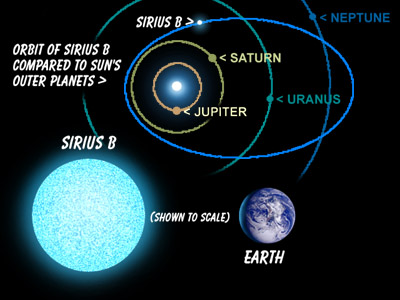
Stars in Canis Major


Stars in Canis Major |

|
|
Deep Sky Object Chart | M41 | M46/M47 | M93 | NGC 2207 | NGC 2217 | NGC 2362 Sirius is the brightest star in the sky...kind of. I had an astronomy professor once who embarrassed me (intentionally, I think) by asking what the brightest star was, and when I piped up "Sirius", he said, "no - the sun". OK OK, true enough, but Sirius is the brightest night time star, in fact by a factor of five - although even that honor is provisional. Sirius is only bright because it is nearby, just 8.6 light years; some other stars actually outshine Sirius by thousands of times, but seem fainter as they are farther away (our Sun similarly cheats; it is actually 23 times fainter than Sirius, but is half a million times closer).Worshipped by the ancient Egyptians as the star of the Nile or star of Isis, Sirius has always gotten lots of attention. The name Sirius is actually Arabic, meaning "the sparkling one" or "the scorcher". The ancient Greeks saw Sirius as a bad influence that "brings drought and diseases on sickly mortals". Even the famous Hippocrates, father of modern medicine, went along with the idea that when Sirius was near the sun in the sky, the "dog days" of summer heralded poor health. I hope he carried malpractice insurance. In India, many thousands of years ago, Sirius was Sukra, the Rain God.
|
||||||||||

|
In more modern times, Sirius gained notoriety as having
a companion of a strange nature: the so-called "pup"
star, which circles Sirius every 50 years. This second
star, first detected in 1844 by its gravitational
effects on Sirius itself, is no easy target for
telescopes, which may account for it being detected
indirectly. The problem is the bright glare of Sirius,
making the much fainter Pup hard to spot. It wasn't
until 1862 that an astronomer got a definite look at the
Pup, and today telescope-equipped astronomers enjoy
repeating the feat as a test of their optics (and,
sometimes, imagination). The angular separation of the
pair varies from 3 to 11.5 arc seconds, and the
companion is a fairly faint magnitude 8.65. The pair
was most widely separated in 1975, and will be again in
2025.
|
|||||||||
|
The companion is one strange Puppy; although it
resembles it's parent star in heat (8500 degrees!) and
thus puts out just as much light per square inch, the
Pup is vastly fainter overall. The answer to this
puzzle is that the Puppy is small - it has fewer of
those square inches! In fact, the Pup is just a little
larger than the Earth...but from its orbital behavior,
we know it still weighs in as heavy as our sun! That's
a lot of mass in one small package (gotta be the Puppy
chow), and it makes for a hellacious surface gravity.
The Pup is not a normal star at all, actually, but is
the collapsed core of a dead one, crushed into a tiny
sphere by gravity when the stellar fusion fire failed
long ago. Our own sun will experience such a fate
billions of years from now - for the moment, the slowly
cooling remains of Sirius B are a nearby reminder that
even the stars are not forever.
Beta Canis Majoris (Murzim) is an interesting variable star, although the light fluctuations are too small to be noticed by the human eye - just 0.03 magnitudes. Also invisible to our eyes but detected by scientific instruments are radial velocity shifts in the star's atmosphere as it swells and contracts. Both effects cycle in a surprisingly short 6 hours - bear in mind that this star is seven times the diameter of our sun, and ten times as heavy to boot. Pulling off a six hour change means the expenditure of vast amounts of energy, and this blue-white giant seems to have plenty of it: Murzim shines 7200 times brighter than our sun, and is located 500 light years away. The star's name means "the announcer", as it rises just before Sirius, the brightest star in the sky. This makes Murzim the celestial equivalent of Ed McMahon to Sirius's Johnny Carson, or better yet, that guy who precedes the president into the Senate chamber and yells "MISTUH SPEEKUH - the president of the United States!" Epsilon Canis Majoris (Adhara) marks the surfer's front foot, and barely missed the arbitrary limit of magnitude 1.49 that is the requirement for "first magnitude" status (the top 21 stars). Leo's Regulus was on the other side of that cut, barely making first magnitude with a rating of 1.36 - but like being in the Fortune 500, Regulus is often thought of as much brighter, as it appears on the "brightest stars" list. Adhara is no slouch, though, and deserves your attention: it is 432 light years away, and shines with a searing blue-white heat of 7000 times brighter than our sun. It is also estimated to be 8.7 times as large as good old Sol. Pi Canis Majoris is an attractive binary star located just east of star cluster M41, and four degrees southeast of Sirius. The two components of the system are magnitudes 5.5 and 9.5, separated by 11.6 arc seconds; a moderate amateur telescope should have no trouble seeing this pair clearly. The primary is a normal yellow-white star 17 brighter than ours; the system is 95 light-years away, at which distance the 11.6 arc second separation of the stars must be at least 300 astronomical units, or ten times the Sun-Pluto distance! Some charts label Pi by another designation, "19 Canis Majoris".
|
||||||||||
|
|
||||||||||